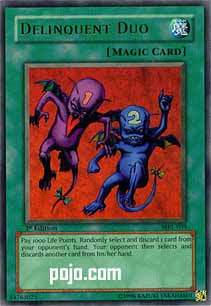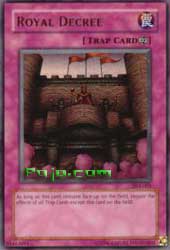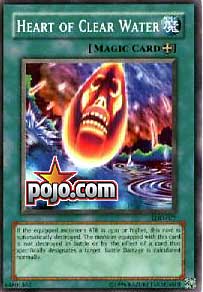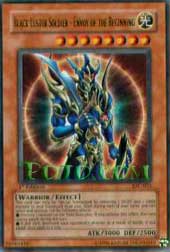|
|
|||||
| Pojo's Yu-Gi-Oh! news, tips, strategies and more! | |||||
|
|
|||||
 |
|||||
|
Card Game Featured Writers Releases + Spoilers Anime Video Games Other
-
Magic
This Space |
napay's Daddio Dueling Den In Part 4 I looked at 7 cards that were in the 2004 World Championship winner’s deck that seemed to be “replacements” for similar cards in the 2003 World Championship winner’s deck. In total I looked at 14 cards. I ended the last article with a question, “Is it good to replace a banned card with a card that carries some negatives or is less powerful?” and I said this wasn’t clear. It’s not clear because the question assumes a static environment. So far this series of articles has focused on the cards in the decks that didn’t change or didn’t change very much. Sure, some cards have been exchanged out, but the overall purpose for having those cards was maintained. Yugioh is a changing environment, new cards get released and other cards get banned. Some cards can be replaced and others are too unique to be replaced. Physics tells us that for every action there is a reaction. Think about how that might apply to Yugioh. In Yugioh, the dueling environment reacts to bans of old cards and releases of new ones. If you go back and read this series from the beginning you’ll find that there are 14 cards I’ve not discussed yet. These 14 cards are the ones that did not repeat and did not seem to be “replaced” with similar cards. It would seem that these cards are the ones that might represent significant change from one year to the next. In this article I’ll be putting these remaining 14 cards on the Star Circle to see what all this might mean. Here are the cards:
2003 cards that did not repeat:
Electric Snake
First I’ll look at the cards that you use to impact your
opponent’s
hand. There are 3 of them; Yata-Garasu, White Magical
Hat and Delinquent Duo. White Magical Hat has a cool
effect, when you do damage your opponent discards. The
difficulty is that its attack is only 1000, which makes
the card vulnerable. Delinquent Duo has been recently
unbanned and a lot of folks are calling it a staple.
(“staple” being a card that should be in every deck) I
don’t know that it’s a staple, but it is a very good way
of destroying your opponent’s hand, they lose 2 cards.
If you think it’s great to pull Pot of Greed and get 2
free cards, then you’re going to hate your opponent
playing Delinquent Duo whereby you lose 2 cards. I like
Delinquent Duo a lot more than White Magical Hat because
you have greater certainty that the effect will go off
and you clean your opponent’s hand of twice as many
cards. This
is probably why Delinquent Duo is on the limited list
and White Magical Hat isn’t. Of course the king of the
trio is Yata-Garasu. I remember the “I Hate Yata” rants
folks would post on the Pojo message boards before there
even were bans. You either owned a Yata card or you
didn’t and if you didn’t you were at a significant
disadvantage to those who had one.
Yata’s effect was
simple, do damage, they skip their draw phase. Both
Yata and Delinquent Duo didn’t repeat in 2004 because
they got banned. White Magical Hat likely lost favor
because there’s uncertainly about getting the effect and
in the game
Three of the cards have the impact of weakening your
opponent’s field. They are Imperial Order, Royal Decree
and Smashing Ground. Nearly half of anyone’s deck is
composed of spell cards. Given that, Imperial Order is
very useful. You pay 700 LP’s per turn to effectively
make about half of your opponent’s deck into useless
draws. This
is an amazing effect and it was so amazing it got
banned. There has been nothing since that comes close
to being “The Next Imperial Order”. Imperial Order
ruled during the age of beatdown and its banning has
resulted in a shift that has encouraged other deck
styles. In terms of new arrivals, Smashing Ground has
become what Fissure never was. There are only about 100
monsters in the game that have a DEF that is greater
2000. When you look over the list of them and you
adjust for the ones that no one ever plays, most of
what’s left is stuff you’d really want Smashing Ground
to get rid of.
On the flip side, if
your opponent has lower DEF monsters, you’re going to
get rid of something and since you get to chose when you
play it, you effectively get to choose what you’re going
to take out. A lot of folks also like Hammer Shot but
Hammer Shot can take out your own monster, which means
you have to be more careful about the timing. One
little note is that both of these cards will get rid of
a monster equipped with Heart of Clear Water, a lot of
folks don’t seem to know that. The other new arrival is
Royal Decree. This is a cool card; a trap version of
Jinzo. Beware, Mystical Space Typhoon was “made” for
clearing Royal Decree. I think it would be interesting
to see which can hold the field longer, Jinzo or Royal
There are 2 cards from the 2003 World Championship winner’s deck that benefit your hand, Electric Snake and Painful Choice. I think Electric Snake is in the same category as White Magical Hat, it’s not a dependable effect and in Yugioh you want effects that are reliable. I also think the banning of Delinquent Duo made this card less favorable. With Delinquent Duo back, I’m wondering if you’ll see Electric Snake back as well. Of course there are some new cards that have a similar effect like Despair from the Dark and the Elephant Statue cards. Painful Choice goes on the list of cards that a lot of folks never fully understood. When you look at what this card does on the Star Circle, it’s just begging to be banned. Improved positioning of 5 cards. That’s 5 cards of unknown position in your deck moved to known positions with one of them going straight to your hand. That’s a fabulous effect and it’s fabulously banned. A lot of folks replaced Painful Choice with Mirage of Nightmare and then Mirage got banned too. The good news is Graceful Charity is now unbanned and you can expect to see one of those in most everyone’s deck in the near future.
The remaining cards all benefit you on your field. They
are Shining Angel, Spirit Reaper, Waboku, Magic
Cylinder, Black Luster Soldier – Envoy of the Beginning
and Magical Scientist. All 6 were cards that showed up
in the 2004 World Championship winner’s deck. Shining
Angel is the Mystic Tomato for light attribute
monsters. The utility of this card is clear if your
goal is to summon chaos monsters. Shining Angel is a
great way to ensure that you have light attribute
monsters in your graveyard. If Black Luster Soldier –
Envoy of the Beginning gets banned I think you’ll see
Shining Angel lose some of that sparkle. Spirit Reaper
is one of the most annoying cards folks play. The thing
doesn’t die. I really like this card because it stalls
your opponent and it forces them to use an effect that
might otherwise have been targeted elsewhere. Waboku is
just plain wonderful. There’s a lot of talk about
whether Threatening Roar might be better. There are two
sides to this. Waboku can be used during your turn sort
of like Kishido Spirit, meaning if you play Waboku and
then attack a monster with an equal attack, yours
survives and your opponent’s is destroyed. Waboku
allows your opponent to attack your facedown cards and
flip them face up, while Threatening Roar prevents them
from attacking at all. Threatening Roar also prevents
your opponent from getting the effect of D.D. Warrior
Lady. Maybe you want your opponent flipping your cards,
maybe you don’t. I like Waboku; mainly because I can
see if my opponent planned to attack first. If they
don’t attack, you can save it for the next turn. Magic
Cylinder is fantastic. It stops your opponent’s attack
then whacks their lifepoints. This is a payback card.
What I love about Magic Cylinder is that it’s both
defensive and offensive; all at the same time. I’ve
mentioned before that getting two effects from one card
is something to think about because this can make your
deck more efficient. Conversely, you need to be aware
that Magic Cylinder has limitations when going up
against monsters that get two attacks per turn and
monsters like Goblin Attack Force that normally change
positions after an attack. Magic Cylinder also doesn’t
destroy the attacking monster. Despite these
shortcomings, I like Magic Cylinder a lot, but I would
understand it if everyone didn’t rush out to get one
immediately. The last card in the list is Magical
Scientist. All by itself, this card changed the game
overnight when it was first released. For a mere 1000
lifepoints, you get to pull a fusion and you may do this
more than once during your turn. Broken? Some think
so, it’s banned now. I think Magical Scientist would
have been balanced if its effect could only be used once
per turn. The whole “first turn kill thing” and the
Mirage Knight abuse was just too much for folks. Now
folks are screaming about Cyber Stein. Don’t even think
about it; 5000 Lifepoints is crazy. If you’re going to
try to work fusions in your deck you should be thinking
about how to use Metamorphosis. The last card in the
list is the biggest one of all, Black Luster Soldier –
Envoy of the Beginning. This card is like Yata-Garasu,
everyone likes to draw it and everyone hates to see it
on their opponent’s side of the field. You know that a
card is strong when it becomes a recurring topic of ban
speculation. While I have no idea whether this card is
going to get banned or not, I can tell you that if it
My first overall observation about these cards is there was a significant shift away from effects that weaken your opponent or strengthen your hand to effects that strengthen your field. 6 cards got added to the list of cards that primarily benefit your field position in 2004. Field advantage trumps hand advantage. The 2004 environment was shifted by chaos and therefore it became more and more important to have a controlling advantage on the field. This shift was also the result of bans and new cards. Clearly, the loss of Yata-Garasu and Imperial Order changed the way we play. Similarly, the introduction of Black Luster Solder – Envoy of the Beginning and Magical Scientist changed the way we construct our decks. I’m not suggesting that there was a total shift to a completely new playing field. I’m saying that out of the 55 cards I’ve considered in this series, the few that got swapped out for totally new cards were swaps that caused the game to be quite different than it was before. Another observation I had was that it’s clear that you want reliable effects in your deck. If the environment changes and you’re not as likely to get the full benefit of a card, it’s time to think about replacing that deck slot. Similarly, when a key card gets added or removed from your deck you need to also assess the support cards in your deck, like Shining Angel. Another comment is the injection of more defensive cards in 2004. Spirit Reaper and Waboku are both defensive cards. Yugioh is largely an offensively oriented game; however, there is clearly a role to be played by defensive cards. You don’t need to be playing a stall deck to benefit from a defensive play. I think finding a balance between offense and defense is something more players should consider. Please feel free to e-mail me thoughts about these cards or the other cards in the series. Maybe I’ll include your thoughts in the next article. notasperfectasyou It’s easy to find me on the message boards, e-mail is ok, but I like open discussion better. If you’re looking for deck ideas, see my Deck Theme’s post on the Pojo Message Boards. napay’s prior articles and why you’d want to read them: “Thoughts and Observations about Winning Decks – Part 4” presents a fourth installment of analysis for the purpose of seeing what can be learned from comparing two proven decks focusing on the issue of replacing cards. “Thoughts and Observations about Winning Decks – Part C” presents a third installment of analysis for the purpose of seeing what can be learned from comparing two proven decks focusing on cards that strengthen your position. “Thoughts and Observations about Winning Decks – Part B” presents a second installment of analysis for the purpose of seeing what can be learned from comparing two proven decks focusing on cards that weaken your opponent. “Thoughts and Observations about Winning Decks – Part A” presents a first installment of deck analysis for the purpose of seeing what can be learned from comparing two proven decks. “Mom and Dad Won’t Let Me Buy Cards On EBAY” presents some thoughts on the good and the bad of buying cards on EBAY and how you might work EBAY for a better experience. “The Exodia FTK” presents an example of applying calculated mathematical probabilities to Yu-Gi-Oh in demonstration of why a deck 40 cards is a good idea. “Fake/counterfeit Yu-Gi-Oh cards” presents a summarized version of my own experience buying fake cards and what I learned from it. “The Star Circle” presents a very visual way to think about the components of your deck and how to think about card flow as a way to improving your deck. “How Big is your Monster” is about why you need to stop thinking about how to get big ATK monsters in your deck and why you do need to think about how cards work synergistically.
|
||||
|
Copyrightę 1998-2005 pojo.com This site is not sponsored, endorsed, or otherwise affiliated with any of the companies or products featured on this site. This is not an Official Site. |
|||||



 of
Yugioh, you want to have the highest likelihood of
getting benefits from the resources you put in your
deck.
of
Yugioh, you want to have the highest likelihood of
getting benefits from the resources you put in your
deck. Decree.
Decree. does
get banned the playing environment will move
significantly. That fact alone is reason enough to lean
towards predicting a ban in the future. Then again,
Black Luster Soldier – Envoy of the Beginning is not
invulnerable. I’m going to table this thought for now
with a promise that I’ll come back to it in a future
article.
does
get banned the playing environment will move
significantly. That fact alone is reason enough to lean
towards predicting a ban in the future. Then again,
Black Luster Soldier – Envoy of the Beginning is not
invulnerable. I’m going to table this thought for now
with a promise that I’ll come back to it in a future
article.